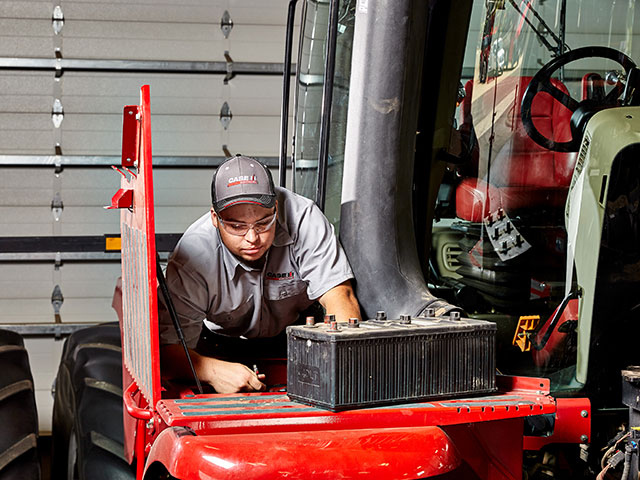How to Care for Batteries Over Winter
Here's How to Keep Your Equipment Batteries Ready for Spring
Harvest is over in most fields. Except for the tractors that run year-round, machinery is parked outside, parked in cold storage, or has a space in the conditioned spaces of warm shops awaiting maintenance and repairs. Down in the guts of these motorized machines are batteries -- key to their operation -- ignored, perhaps, until that moment when the engine is supposed to turn over, but there is only silence.
DTN/Progressive Farmer spoke with Josh Goldsworthy, product manager for batteries at Case IH Aftermarket Solutions, about battery care and maintenance. He gave us the rundown on battery care and maintenance over the winter.
**
DTN/PF: Thanks, Josh, for sitting down with us today. Give us the overview on batteries. What works best in farm machinery? What's not the best choice?
Goldsworthy: Although automotive-style batteries may start your equipment, a heavy-duty battery such as the Case-IH MagnaPower premium heavy-duty battery is a better solution for off-highway applications. They are built to withstand the harsh environments that can knock the life out of other batteries. They have large inner-cell connectors to make sure that the connection between the battery posts and internal plates remains consistent, that there's no wear or breakage. They also have an epoxy anchor bonding. And what this does is this secures the bottom of the plates to the battery itself. So, as your equipment is going through a rough field, bouncing around and jolting around, taking a lot of abuse, all those internal battery plates stay in position where they're supposed to be, and they don't touch each other -- which can cause shorts, which can cause failures that might not be visible on the outside of the battery. Epoxy anchor bonding helps eliminate that and helps ensure that the batteries withstand harsh field conditions.
P[L1] D[0x0] M[300x250] OOP[F] ADUNIT[] T[]
DTN/PF: So, we're talking about the care and maintenance of batteries. You are an industry expert, where would you start?
Goldsworthy: The first, and most basic, step farmers can take to make sure that their batteries will make it through winter is to clean the dirt and debris off the battery. Dirt and debris can create a conductive path and might drain your battery faster than if it was clean. Make sure there's no corrosion around the posts and the terminals. Clean them with a terminal cleaner and a brush.
DTN/PF: OK. Let's say the battery is going to be stored outside or in cold storage.
Goldsworthy: If your equipment is going to be stored outside in very cold temperatures, it would be a good idea to remove that battery and instead store it indoors with a trickle charger on it. Storing equipment in a shed, especially in a climate-controlled shed, is ideal. But you should still put a simple battery maintainer on it to help prevent that battery from discharging. It's an easy way to ensure your battery maximizes its life.
DTN/PF: What about starting the equipment from time to time?
Goldsworthy: Running the equipment is a good idea. Start the machine and let the machine run at an idle. The alternator will charge the battery. But let the equipment run long enough -- a couple of minutes might not be enough to put enough of a charge back into that battery. That time depends on how long that battery has set there unused or unmaintained. There are other equipment benefits such as running the oil through the system. If you store your equipment outside or in very cold environments, and you let the battery totally discharge, the battery acid inside the battery can get to a consistency more equivalent to water than acid. It can freeze inside the battery, which can obviously cause internal damage you might not see until you start the equipment later in the season. If you keep a maintainer on the battery, it should not freeze.
DTN/PF: When is it time to change the battery.
Goldsworthy: If you don't maintain it, if you allow it to fully discharge or fully drain, that is when you can start getting susceptible to freezing; the battery might swell. Use a battery tester. Often, in warm weather, the battery will start fine. But as it starts getting colder, even into harvest, you're noticing it struggles to start. That might be an indication it's ready to be replaced. But you really need a battery tester to prove that it's time to replace the battery.
Dan Miller can be reached at dan.miller@dtn.com
Follow him on Twitter @DMillerPF
(c) Copyright 2021 DTN, LLC. All rights reserved.




